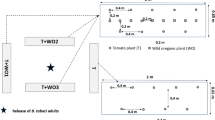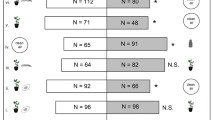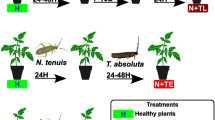Abstract
Tomato leaf miner, Tuta absoluta is a ravaging pest of tomato in many countries of the world including Tanzania. The pest inflicts substantial damage to tomato crop that causes a huge loss to farmers. This study focused on evaluating potentials of shared volatiles emanated from four hosts of the pest, namely tomato, aubergine, sweet pepper and watermelon in formulating attractant for female T. absoluta. Y-tube olfactometer was used to evaluate attractiveness of leaf volatiles from four hosts and a blend of shared compounds and GC-MS was used to identify volatile constituents of the four hosts. Results indicate that, female T. absoluta were attracted to volatiles of tomato volatiles (χ2 = 4.9, P < 0.05) and repelled by watermelon volatiles (χ2 = 6.4, P < 0.05). We further observed high composition of terpenes in tomatoes (70%) as compared to other hosts, which might have contribute to its observed attraction compared to the other hosts. On the other hand, watermelon was highly constituted by green leaves volatiles (GLVs) which is suggested to account for the observed repellency. Thus, shared compounds that do not contain GLVs significantly attracted female T. absoluta at a dose of 10 μl (χ2 = 8.1, P < 0.05). Our findings have revealed that, compounds shared by hosts attract females T. absoluta. Therefore, results from this study have laid groundwork in the development of attractant for management and monitoring of the pest.




Similar content being viewed by others
References
Ameye, M., Allmann, S., Verwaeren, J., Smagghe, G., Haesaert, G., Schuurink, R. C., & Audenaert, K. (2018). Green leaf volatile production by plants: A meta-analysis. New Phytologist, 220, 666–683. https://doi.org/10.1111/nph.14671.
Asuming, W. A., Beauchamp, P. S., Descalzo, J. T., Dev, B. C., Dev, V., Frost, S., & Ma, C. W. (2005). Essential oil composition of four Lomatium Raf. Species and their chemotaxonomy. Biochemical systematics and ecology. https://doi.org/10.1016/j.bse.2004.06.005.
Ataide, L. M. S., Arce, C. C. M., Curtinhas, J. N., da Silva, D. J. H., DeSouza, O., & Lima, E. (2017). Flight behavior and oviposition of Tuta absoluta on susceptible and resistant genotypes of Solanum lycopersicum. Arthropod-Plant Interactions, 11, 567–575. https://doi.org/10.1007/s11829-017-9500-1.
Baldwin, I. T., Halitschke, R., Paschold, A., Von Dahl, C. C., & Preston, C. A. (2006). Volatile signaling in plant-plant interactions: "talking trees" in the genomics era. Science, 311, 812–815. https://doi.org/10.1126/science.1118446.
Bawin, T., Dujeu, D., De Backer, L., Francis, F., & Verheggen, F. J. (2016). Ability of Tuta absoluta (Lepidoptera: Gelechiidae) to develop on alternative host plant species. Canadian Entomologist, 148, 434–442. https://doi.org/10.4039/tce.2015.59.
Biasazin, T. D., Herrera, L. S., Kimbokota, F., & Dekker, T. (2018). Translating olfactomes into attractants: Shared volatiles provide attractive bridges for polyphagy in fruit flies. Ecology Letters, 22, 108–118. https://doi.org/10.1111/ele.13172.
Biasazin, T. D., Karlsson, M. F., Hillbur, Y., Seyoum, E., & Dekker, T. (2014). Identification of host blends that attract the African invasive fruit fly. Bactrocera invadens. Journal of Chemical Ecology, 40, 966–976. https://doi.org/10.1007/s10886-014-0501-6.
Blassioli-Moraes, M. C., Borges, M., Michereff, M. F. F., Magalhães, D. M., & Laumann, R. A. (2016). Semiochemicals from plants and insects on the foraging behavior of Platygastridae egg parasitoids. Pesquisa Agropecuária Brasileira, 51, 454–464. https://doi.org/10.1590/S0100-204X2016000500005.
Brown, W. L., Eisner, T., & Whittaker, R. H. (1970). Allomones and kairomones: Transspecific chemical messengers. Bioscience, 20, 21–22. https://doi.org/10.2307/1294753.
Catalayud, P. A., Ahuya, P., & Le Ru, B. (2014). Importance of the experimental setup in research on attractiveness of odours in moths: An example with Busseola fusca. Entomologia Experimentalis et Applicata, https://doi.org/10.1016/j.phytochem.2011.04.011.
Chidege, M., Al-zaidi, S., Hassan, N., Julie, A., Kaaya, E., & Mrogoro, S. (2016). First record of tomato leaf miner Tuta absoluta (Meyrick) (Lepidoptera: Gelechiidae) in Tanzania. Agriculture and Food Security, https://doi.org/10.1186/s40066-016-0066-4.
Cho, K. S., Lim, Y. R., Lee, K., Lee, J., Lee, J. H., & Lee, I. S. (2017). Terpenes from forests and human. Healthy and Toxicology Research, 105487/TR.2017.33.2.097.
Dembilio, Ó. & Jaques, J. A. (2015). Biology and management of red palm weevil. In W. Wakil., J. R. Faleiro & T. A. Mille (Eds.). Sustainable pest management in date palm: Current status and emerging challenges (pp. 13–36). Switzerland: Springer.
Desneux, N., Wajnberg, E., Wyckhuys, K. A. G., Burgio, G., Arpaia, S., Narvaez-Vasquez, C. A., et al. (2010). Biological invasion of European tomato crops by Tuta absoluta: Ecology, geographic expansion and prospects for biological control. Journal of Pest Science, 83, 197–215. https://doi.org/10.1007/s10340-010-0321-6.
Dicke, M., & Sabelis, M. W. (1992). Costs and benefits of chemical information conveyance: Proximate and ultimate factors. In B. D. Roitberg & M. B. Isman (Eds.), Insect chemical ecology: An evolutionary approach (pp. 122–125). New York: Chapman and Hall.
Ehrlich, P. R., & Raven, P. H. (1964). Butterflies and plants: A study in coevolution. Evolution, https://doi.org/10.2307/2406212.
European and Mediterranean Plant Protection Organization (EPPO). (2005). European and Mediterranean plant protection organization, data sheets on quarantine pests: Tuta absoluta. EPPO Bulletin, 35, 434–435.
Fernandez, S., & Montagne, A. (1990). Preferencia de oviposicion de las hembrasy duracion, crecimiento y sobrevivencia de las larvas de Scrobipalpula absoluta (Meyrick) en diferentes Solanaceas. Boletín de entomología venezolana, 5(13), 100–106.
Forero, M. D., Quijano, C. E., & Pino, J. A. (2009). Volatile compounds of Chile pepper (Capsicum annuum L. var. glabriusculum) at two ripening stages. Flavour and Fragrance Journal, https://doi.org/10.1002/ffj.1913.
Global Plants Protection News (GPPN). (2015). http://www.plantprotection.org/resources.html. Accessed 21 December 2018.
Guedes, C., & Picanço, C. (2012). The tomato borer, Tuta absoluta in South America: Pest status, management and insecticide resistance. EPPO Bulletin, 42, 211–216.
Guler, Z., Candir, E., Yetisir, H., Karaca, F., & Solmaz, I. (2013). Volatile organic compounds in watermelon (Citrullus lanatus) grafted onto 21 local and two commercial bottle gourd (Lagenaria: Siceraria) rootstocks. Journal of Horticulture, Science and Biotechnology, 89, 448–452. https://doi.org/10.1080/14620316.2014.11513105.
Harizanova, V., Stoeva, A., & Mohamedova, M. (2009). Tomato leaf miner, Tuta absoluta (Povolny) (Lepidoptera: Gelechiidae) - first record in Bulgaria. Journal of Agriculture, Science and Technology, 1(3), 95–98.
Hazzit, M., Baaliouamer, A., Faleiro, M. L., & Miguel, M. G. (2006). Composition of the essential oils of Thymus and Origanum species from Algeria and their antioxidant and antimicrobial activities. Journal of Agricultural and Food Chemistry, 54, 6314–6321. https://doi.org/10.1021/jf0606104.
Hirao, T., Okazawa, A., Harada, K., Kobayashi, A., Muranaka, T., & Hirata, K. (2012). Green leaf volatiles enhance methyl jasmonate response in Arabidopsis. Journal of Bioscience and Bioengineering, 114, 540–545. https://doi.org/10.1016/j.jbiosc.2012.06.010.
Khan, M., Al-Saleem, M. S., & Alkhathlan, H. Z. (2016). A detailed study on chemical characterization of essential oil components of two Plectranthus species grown in Saudi Arabia. Journal of Saudi Chemical Society, 20, 711–721. https://doi.org/10.1016/j.jscs.2016.03.006.
Khan, Z. R., Midega, C. A. O., Amudavi, D. M., Hassanali, A., & Pickett, J. A. (2008). On-farm evaluation of the ‘push–pull’ technology for the control of stemborers and striga weed on maize in western Kenya Field Crops Research, 106, 224–233.
Lance, D. R. (1983). Host seeking behaviour of the gypsy moth: The influence of polyphagy and highly apparent host plants. In S. Ahmad (Ed.), Herbivorous insects, host seeking behaviour and mechanisms (pp. 201–224). New York: Academic Press.
Lopes, D., Strobl, H., & Kolodziejczyk, P. (2004). 14-Methylpentadecano-15-lactone (Muscolide): A new macrocyclic lactone from the oil of Angelica archangelica L. Chemical Biodiversity, 1, 1880–1887. https://doi.org/10.1002/cbdv.200490144.
Magalhães, D. M., Borges, M., Laumann, R. A., Woodcock, C. M., Withall, D. M., Pickett, J. A., Birkett M. A., Blassioli-Moraes M. C. (2018). Identification of volatile compounds involved in host location by Anthonomus grandis. Front. Ecol. Evolution 6, https://doi.org/10.3389/fevo.2018.00098.
Maggio, A., Rosselli, S., Bruno, M., Spadaro, V., Raimondo, F. M., & Senatore, F. (2012). Chemical composition of essential oil from Italian populations of Artemisia alba Turra (Asteraceae). Molecules, 17, 10232–10241. https://doi.org/10.3390/molecules170910232.
Mainga, B., Saha, H. M., & Mwololo, J. K. (2018). Use of cattle manure, calcium ammonium nitrate and diammonium phosphate in watermelon (Citrullus lanatus (Thunb.) Matsum and Nakai) production increases fruit quality and maximize small holder farmers’ net returns and profits. Horticulture International Journal, https://doi.org/10.15406/hij.2018.02.00059.
Mansour, R., Brévault, T., Chailleux, A., Cherif, A., Grissa-Lebdi, K., Haddi, K., Mohamed, S. A., Nofemela, R. S., Oke, A., Sylla, S., Tonnang, H. E. Z., Zappalà, L., Kenis, M., Desneux, N., & Biondi, A. (2018). Occurrence, biology, natural enemies and management of Tuta absoluta in Africa. Entomologia Generalis, 38, 83–112. https://doi.org/10.1127/entomologia/2018/0749.
Mansour, S. A. A., Roff, M., Saad, K. A., Abuzid, I., Kermani, N. M., & Idris, A. B. (2015). Identification of semiochemicals released by brinjal, tomato, okra and chilli plants infested with whitefly. B. tabaci. Libyan Journal of Basic Sciences, 2, 25–40.
Matsui, K., Sugimoto, K., Mano, J. I., Ozawa, R., & Takabayashi, J. (2012). Differential metabolisms of green leaf volatiles in injured and intact parts of a wounded leaf meet distinct ecophysiological requirements. PLoS One, 7, e36433. https://doi.org/10.1371/journal.pone.0036433.
Miano, R. N. (2017). Behavioral responses of Tuta absoluta to a wild and cultivated tomato plants and characterization of the mediating semiochemical blends. M.Sc Dissertation, Kenyatta University.
Midega, C. A. O., Bruce, T. J., Pickett, J. A., Murage, A. W., & Khan, Z. R. (2015). Climate- adapted companion cropping increases agricultural productivity in East Africa. Field Crops Research, 180, 118–125. https://doi.org/10.1016/j.fcr.2015.05.022.
Midega, C. A. O., Pittchar, J., Salifu, D., Pickett, J. A., & Khan, Z. R. (2013). Effects of mulching. N-fertilization and intercropping with Desmodium uncinatum on Striga hermonthica infestation in maize. Crop Protection, 44, 44–49. https://doi.org/10.1016/j.cropro.2012.10.018.
Miyazawa, M., Nomura, M., Marumoto, S., & Mori, K. (2013). Characteristic odor components of essential oil from Scutellaria laeteviolacea. Journal of Oleo Science, 62, 51–56. https://doi.org/10.5650/jos.62.51.
Mohamed, E. S. I., Mahmoud, M. E. E., Elhaj, M. A. M., Mohamed, S. A., & Ekesi, S. (2015). Host plants record for tomato leaf miner Tuta absoluta (Meyrick) in Sudan. EPPO Bulletin, 45, 108–111. https://doi.org/10.1111/epp.12178.
Moussa, S., Sharma, A., Baiomy, F., & Eid El-Adl, F. (2013). The status of tomato Leafminer; Tuta absoluta (Meyrick) (Lepidoptera: Gelechiidae) in Egypt and potential effective pesticides. Academic Journal of Entomology. https://doi.org/10.5829/idosi.aje.2013.6.3.75130.
Mumm, R., Posthumus, M. A., & Dicke, M. (2008). Significance of terpenoids in induced indirect plant defence against herbivorous arthropods. Plant, Cell and Environment, 31, 575–585. https://doi.org/10.1111/j.1365-3040.2008.01783.x.
Murage, A. W., Pittchar, J. O., Midega, C. A. O., Onyango, C. O., & Khan, Z. R. (2015). Gender specific perceptions and adoption of the climate-smart push-pull technology in eastern Africa. Crop Protection, 76, 83–91. https://doi.org/10.1016/j.cropro.2015.06.014.
Murali-Baskaran, R. K., Sharma, K. C., Kaushal, P., Kumar, J., Parthiban, P., Senthil-Nathan, S., & Mankin, R. W. (2018). Role of kairomone in biological control of crop pests. Physiological and Molecular Plant Pathology, 101, 3–15. https://doi.org/10.1016/j.pmpp.2017.07.004.
Nishida, R. (2014). Chemical ecology of insect–plant interactions: Ecological significance of plant secondary metabolites. Bioscience, Biotechnology and Biochemistry, 78, 1–13. https://doi.org/10.1080/09168451.2014.877836.
Pickett, J. A., Woodcock, C. M., Midega, C. A. O., & Khan, Z. R. (2014). Push–pull farming systems. Current Opinion in Biotechnology, 26, 125–132. https://doi.org/10.1016/j.copbio.2013.12.006.
Quijano-Célis, C. E., Echeverri-Gil, D., Ruiz, Y., & Pino, J. A. (2013). Volatiles from Syzygium paniculatum fruit. Natural Product Communications, 8(1), 129–130.
Roditakis, E., Vasakis, E., Grispou, M., Stavrakaki, M., Nauen, R., Gravouil, M., & Bassi, A. (2015). First report of Tuta absoluta resistance to diamide insecticides. Journal of Pest Science, 88, 9–16. https://doi.org/10.1007/s10340-015-0643-5.
Roussis, V., Tsoukatou, M., Petrakis, P. V., Chinou, I., Skoula, M., & Harborne, J. B. (2000). Volatile constituents of four Helichrysum species growing in Greece. Biochemical Systematics and Ecology, 28, 163–175. https://doi.org/10.1016/s0305-1978(99)00046-0.
Ruther, J., Meiners, T., & Steidle, J. (2002). Rich in phenomena-lacking in terms. A classification of kairomones. Chemoecology, 12, 161–167. https://doi.org/10.1007/PL00012664.
Salama, E. R., Abd, H. S., Ismail, I. A. K., Ebadah, I., Shehata, I., & Fouda, M. (2015). Some ecological and behavioural aspects of the tomato leaf miner Tuta absoluta (Meyrick) (Lepidoptera: Gelechiidae). Ecologia Balkanica., 7(2), 35–44.
Sarwar, M. (2015). Biopesticides: An effective and environmental friendly insect-pests inhibitor line of action. International Journal of Engineering and Advanced Research Technology, 1(2), 10–15.
Scala, A., Allmann, S., Mirabella, R., Haring, M., & Schuurink, R. (2013). Green leaf volatiles: A plant’s multifunctional weapon against herbivores and pathogens. International Journal of Molecular Sciences, 14, 17781–17811. https://doi.org/10.3390/ijms140917781.
Senatore, F., Formisano, C., Rigano, D., Piozzi, F., & Rosselli, S. (2007). Chemical composition of the essential oil from aerial parts of Stachys palustris L. (Lamiaceae) growing wild in southern Italy. Croatica Chemica Acta, 80(1), 135–139.
Smith, J. D., Dubois, T., Mallogo, R., Njau, E. F., Tua, S., & Srinivasan, R. (2018). Host range of the invasive tomato pest Tuta absoluta Meyrick (Lepidoptera: Gelechiidae) on Solanaceous crops and weeds in Tanzania. Florida Entomologist, 101. https://doi.org/10.1653/024.101.0417.
Tanaka, T., Ikeda, A., Shiojiri, K., Ozawa, R., Shiki, K., Nagai-Kunihiro, N., Fujita, K., Sugimoto, K., Yamato, K. T., Dohra, H., Ohnishi, T., Koeduka, T., & Matsui, K. (2018). Identification of a hexenal reductase that modulates the composition of green leaf volatiles. Plant Physiology, 178, 552–564. https://doi.org/10.1104/pp.18.00632.
Tasin, M., Bäckman, A. C., Bengtsson, M., Ioriatti, C., & Witzgall, P. (2006). Essential host plant cues in the grapevine moth. Naturwissenschaften, 93, 141–144. https://doi.org/10.1007/s00114-005-0077-7.
Turlings, T. C., Loughrin, J. H., Mccall, P. J., Röse, U. S., Lewis, W. J., & Tumlinson, J. H. (1995). How caterpillar-damaged plants protect themselves by attracting parasitic wasps. Proceedings of the National Academy of Sciences, 92, 4169–4174. https://doi.org/10.1073/pnas.92.10.4169.
Urbaneja, A., Vercher, R., Navarro, V., Porcuna, J. L., & Garcia-Marı, F. (2007). The tomato moth. Tuta absoluta. Phytoma Espana., 194, 16–23.
Vacas, S., Melita, O., Michaelakis, A., Milonas, P., Minuz, R., Riolo, P., Abbass, M. K., Lo Bue, P., Colazza, S., Peri, E., Soroker, V., Livne, Y., Primo, J., & Navarro-Llopis, V. (2016). Lures for red palm weevil trapping systems: Aggregation pheromone and synthetic kairomone. Pest Management Science, 73, 223–231. https://doi.org/10.1002/ps.4289.
Webster, B., Bruce, T., Dufour, S., Birkemeyer, C., Birkett, M., Hardie, J., & Pickett, J. (2008). Identification of volatile compounds used in host location by the black bean aphid. Aphis fabae. Journal of Chemical Ecology, 34, 1153–1161. https://doi.org/10.1007/s10886-008-9510-7.
Wertheim, B., Allemand, R., Louise, E., Vet, M., & Dicke, A. (2006). Effects of aggregation pheromone on individual behaviour and food web interactions: A field study on drosophila. Ecological Entomology, https://doi.org/10.1111/j.1365-2311.2006.00757.x.
Wink, M. (2018). Plant secondary metabolites modulate insect behavior-steps toward addiction? Frontiers in Physiology, 9. https://doi.org/10.3389/fphys.2018.00364.
Yang, K., Liu, Q. Z., Liu, Z. L., & Du, S. S. (2012). GC-MS analysis of insecticidal essential oil of aerial parts of Paederia scandens (Lour) Merrill (Rubiaceae). Tropical Journal of Pharmaceutical Research, 11(3), 461–467.
Younes, A. A., Zohdy, N. Z. M., Abul, F. H., & Fathy, R. (2018). Preference and performance of the tomato leaf miner, Tuta absoluta (Lepidoptera-Gelechiidae) towards three Solanaceous host plant species. CPQ Microbiology, 1(3), 1–16.
Zhao, Y. P., Wang, X. Y., Wang, Z. C., Lu, Y., Fu, C. X., & Chen, S. Y. (2006). Essential oil of Actinidia macrosperma, a catnip response kiwi endemic to China. Journal of Zhejiang University Science B, 7, 708–712. https://doi.org/10.1631/jzus.2006.b0708.
Acknowledgements
The project was funded by Mkwawa University College of Education (MUCE) under the University of Dar es Salaam (UDSM) Competitive Research Grants, Project No. MUCE-18114.
Author information
Authors and Affiliations
Corresponding author
Ethics declarations
Conflict of interest
The authors declare that they have no conflict of interest.
Additional information
Publisher’s note
Springer Nature remains neutral with regard to jurisdictional claims in published maps and institutional affiliations.
Rights and permissions
About this article
Cite this article
Msisi, D., Matojo, N.D. & Kimbokota, F. Attraction of female tomato leaf miner, Tuta absoluta (Meyrick, 1917) (Lepidoptera:Gelechiidae) to shared compounds from hosts. Phytoparasitica 49, 153–162 (2021). https://doi.org/10.1007/s12600-020-00848-x
Received:
Accepted:
Published:
Issue Date:
DOI: https://doi.org/10.1007/s12600-020-00848-x




